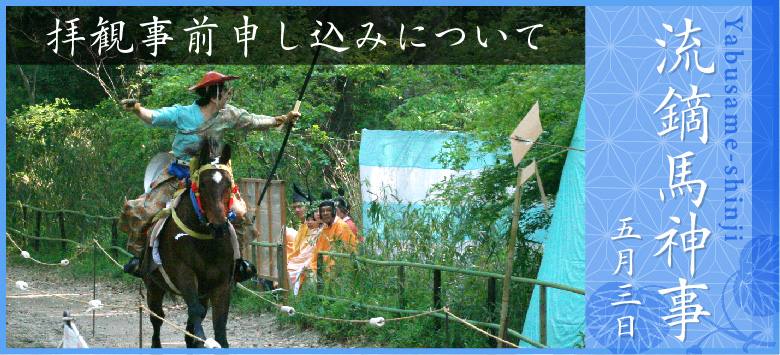Wedding ceremony application
Weekdays: 11:00am - 4:00pm Saturdays, Sundays and holidays: 10:00am - 4:00pm Phone reception: 0120-480-451

Special viewing
Information on special viewing
Twelve-layered Robe and Imperial Dance: God's Kitchen [Oidono]
At Shimogamo Shrine, you can try on the traditional 12-layered kimono and watch the Imperial Dance of Oidono throughout the year.
We are offering this service to groups.
Twelve-layered Robe and Imperial Dance: God's Kitchen
[Oidono]
At Shimogamo Shrine, you can wear the twelve-layered kimono all year round.
We offer tours of the Ochobu Dance and Oiden Hall for groups.
Notification setting date
We operate this service every day throughout the year, however there are no tours scheduled on New Year's Day or on the day of the Kamo Festival.
Number of people
Approximately 80 people per tour
*There are 80 seats for viewing the twelve-layered ceremonial robes. If there are more than 100 people, we may have to split the tour into two sessions. In that case, you will be required to pay the fee for two sessions.
*Consultation required
Tour times
The tour will last approximately one hour, but can be extended upon request.
Visit to Oido Hall, Jinguji Temple ruins, and Kamosha Museum Hidehosha
Visiting hours
10:00am - 4:00pm
Admission fee
Adult 1000 yen
Junior high school students and younger: Free
Dressing in twelve-layered kimono and court dance
We will explain the process of putting on the "Junihitoe" robe, which is still used today in the Aoi Festival and other events, and explain how to wear it. After you have put on the robe, you will be able to watch a traditional imperial dance in the 12-layered robe at the Important Cultural Property (Mitsui Shrine Dance Hall). (Reservation required)


Otaiden (Important Cultural Property)/Okurumasha
The Oidono Hall (God's Kitchen) and Well House, where offerings to the gods (shinsen) were prepared, are open to the public. There is a special exhibition of replicas of offerings handed down since ancient times, such as the special sacred offerings for the Aoi Festival, as well as cooking utensils. In the separate building, the carriage house, there is an exhibition of materials related to the Aoi Festival that have been handed down since ancient times. (Exhibits are changed periodically.)
Otaiden (Important Cultural Property)/Okurumasha
The Important Cultural Property Oidono (God's Kitchen) and Well House, where offerings to the gods (shinsen) were prepared, are open to the public. There is a special exhibition of replicas of offerings handed down since ancient times, such as the special sacred offerings for the Aoi Festival, as well as cooking utensils. In the separate carriage house, materials related to the Aoi Festival that have been handed down since ancient times are on display (exhibits are changed periodically).

The Shinfukuden Hall (Important Cultural Property) - The Unopened Room and the "Throne Room"
Since the Heian period, the Shinpukuden Hall has been the Emperor's throne room in emergencies, and the room has long been known as the "unopened room" and has been forbidden to be used on a normal basis. You will be able to see the throne room (the chair used by the Emperor and Empress when they visited the temple in 1994) and receive an explanation. (Reservation required)


Kamo no Chomei's "Hojo Hermitage"
Located within Kawai Shrine, which is associated with Kamo no Chomei, this exhibit displays a restoration of the "Hojo no hermitage," the residence of Kamo no Chomei, the author of "Hojoki," that has been academically researched and verified. Materials related to Kamo no Chomei are also on display.
Kamo no Chomei's "Hojo Hermitage"
An academically researched and verified reconstruction of the "Hojo Hermitage," the residence of Kamo no Chomei, author of the "Hojoki," is on display in the viewing area of the former Jinguji Temple ruins.

Kamosha Museum Hidehosha
The Kamo Shrine Museum is a residence of the Asada family, who were academic painters at Shimogamo Shrine, and hosts various exhibitions depending on the period.
Opening hours: 10:00am - 4:00pm





